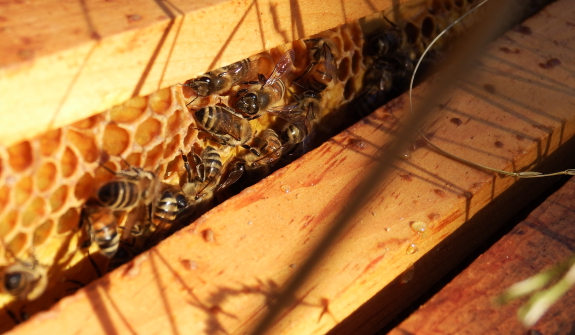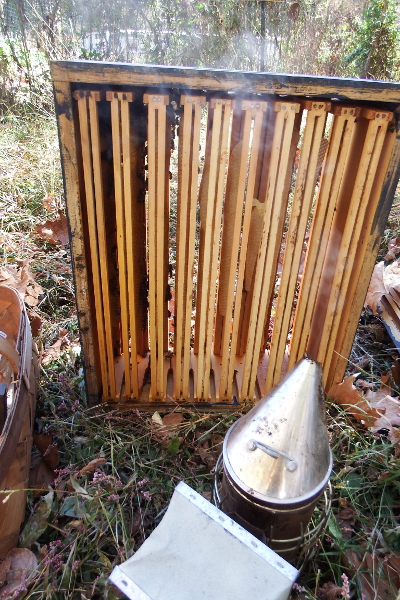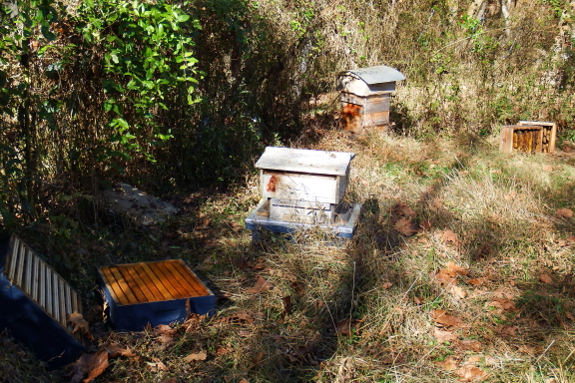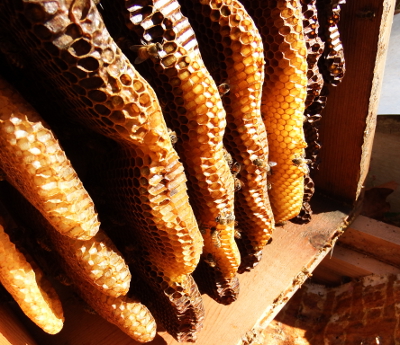
Streamlining the hives for winter

"How are our girls?" Mark asked.
We use that term for our
goats and our chickens...and apparently now our honeybees. "Oh, you mean
our thousands of girls?" I answered. "They've got enough honey for the
winter, but none for us...again."
 The mother hive --- our Langstroth/Warre hybrid --- was doing the best, probably because I fed them a couple of gallons of sugar water in September. The hive now consists of one very heavy Warre box chock full of honey, with a lighter honey-and-brood Langstroth box below.
The mother hive --- our Langstroth/Warre hybrid --- was doing the best, probably because I fed them a couple of gallons of sugar water in September. The hive now consists of one very heavy Warre box chock full of honey, with a lighter honey-and-brood Langstroth box below.
Since we'll be
overwintering the hive as a hybrid, I went ahead and took away the two
Langstroth supers I'd optimistically placed on the bottom of the hive.
The bees had built some comb in one of them, but clearly lacked the
capacity to do any more after a spring split followed by a swarm. Oh well, there's always next year to get them all the way down into the Langstroth box and to hope for honey for us!

I thought
the daughter hive was down to one very heavy honey box and a lighter
honey-and-brood box as well. In fact, the photo above was meant to be my
"after" picture, showing how I'd left the removed boxes beside the
hives for the night so our girls could clean out any nectar they might
have been dehydrating within those combs. But there sure seemed to be a
lot of activity around one of those Warre boxes....
I walked back over to
take a look, and sure enough that box included some capped honey! Not
enough to make it easy to see by looking up through the bottom (my
method of  inspecting
Warre boxes since the frames usually end up glued to the sides and tear
if you try to lift them out). The visual inspection plus the lightness
of the box had convinced me that it was mostly bare comb. Looks like I
was wrong!
inspecting
Warre boxes since the frames usually end up glued to the sides and tear
if you try to lift them out). The visual inspection plus the lightness
of the box had convinced me that it was mostly bare comb. Looks like I
was wrong!
In a Langstroth hive, I
would have gone through both light boxes and consolidated all the honey
into one box so the bees would have less space to heat over the winter,
but that's not really possible in a Warre hive. So I plopped the third
box back on top, figuring our daughter colony could use the capped honey
and whatever dehydrating nectar was in the other frames to top off
their barely sufficient stores.
That's pretty much it for bee chores until spring since our fall varroa mite test came back very clean.
I'll slip in the bottom-board inserts before long and cross my fingers
that our hives will make it through the most dangerous time of their
lives --- the winter.
In the meantime, I'll
count my apicultural blessings. Even if we didn't end up with honey, we
doubled our hives this year for the price of about thirty pounds of
sugar, but with no purchased bees. Sounds like a success to me!
Want more in-depth information? Browse through our books.
Or explore more posts by date or by subject.
About us: Anna Hess and Mark Hamilton spent over a decade living self-sufficiently in the mountains of Virginia before moving north to start over from scratch in the foothills of Ohio. They've experimented with permaculture, no-till gardening, trailersteading, home-based microbusinesses and much more, writing about their adventures in both blogs and books.
Want to be notified when new comments are posted on this page? Click on the RSS button after you add a comment to subscribe to the comment feed, or simply check the box beside "email replies to me" while writing your comment.
